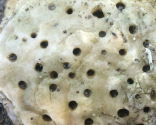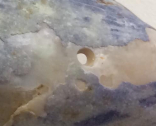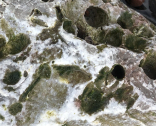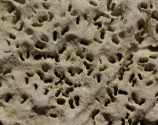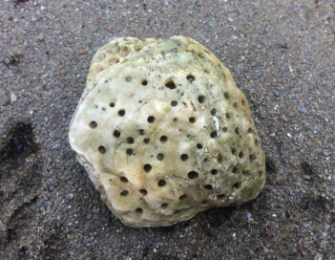

What makes holes in
rocks, stones and shells?
Warning this page contains lots of boring things - but they are actually very interesting despite their habit of boring...
Pick your hole!
Telltale holes: lots of small round holes, usually in shells, generally but not exclusively in oyster shells.
This boring sponge is bright yellow and relatively common around the coasts of the UK. It bores into shells and limestones, using acids to dissolve the calcium carbonate. The aim is not to kill the mollusc in the shell but that can be a consequence as the shell will eventually crumble away when too many holes in are made.

Signs of a boring sponge's work on an oyster shell.
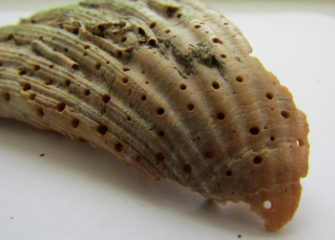
Signs of a boring sponge's work on a scallop shell.
Whelks and other carnivorous molluscs
Telltale holes: a single perfectly drilled hole in a shell, in which their is no longer a living snail.
Not all sea molluscs are peace-loving, algae-munching lovable beasts like the periwinkle! Oh no. We have a raft of Driller Killers too!
They include the Common Whelk, Dog Whelk, Moon Snail (aka Necklace Shell). Their sole mission in life (other than making Driller Killer babies) is to get into the soft, meaty bodies of other molluscs and consume them. Creatures like starfish, crabs, sea otters will try to prise open a shell but not the Driller Killers - they go the direct route by drilling straight through the shells. They use their radula - the equivalent of their tongues - as a raspy drill. They then squirt their digestive juices through the hole to start the digestive process off and suck out the goo that was once a snail.
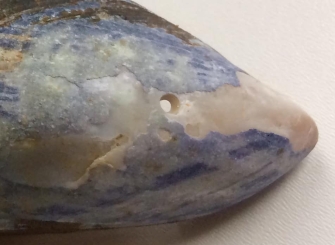
This tiny hole in a mussel shell was probably made by a dog whelk.
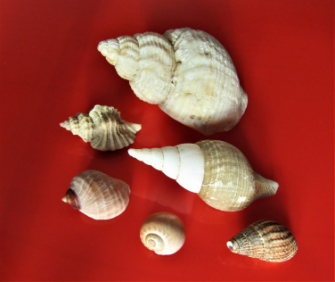
A few of our more common Driller Killers. Top is the common whelk and clockwise from hi, we have a slender spindle (colus) whelk, nettwed dog whelk, moon snail (neccklance shell), dog whelk and a sting winkle (more on these on this page).
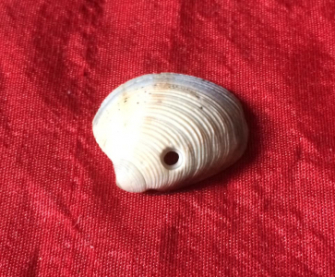
A larger hole (4mm across) probably made by a whelk.
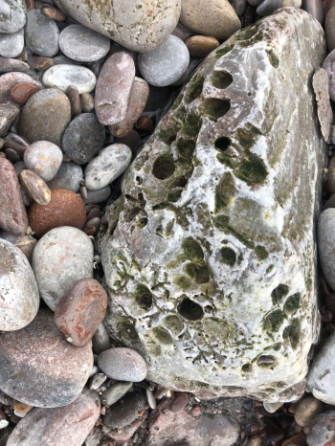
There are a number of clams which can bore into relatively soft stone (such as mudstone) to make their homes. The advantage of this is that they get a safe place to live away from predators (see the Driller Killers above as an example!) and the waves. The disadvantage is that if the chosen rock or stone gets flung onto the beach, they cannot get out, pick it up and put back into the sea again. It is also a lot of effort to make these holes, so once a clam has done the digging, they don't move; that's it for life.

The most "famous" of the rock-boring clam world is the piddock. In UK waters, there are two relatively common species of clams generally known as piddocks - Pholas dactylus and Barnea candida.
They can grow up to 12 cm long and can live for up to eight years. They are filer feeders which means they take in sea water through a syphon that they stick out of the top of their hole in the rock and suck in the floaty goodness.
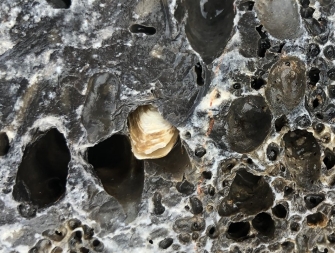
Above are the two shell halves of a piddock in a hole surrounded by the holes of former picddock inhabitants.
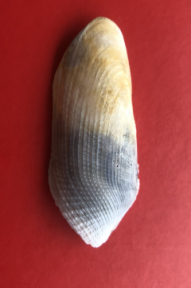
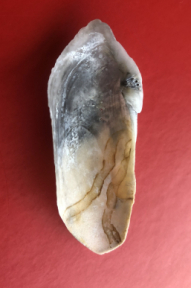
The shell of a piddock. They tend to look quite twisted and 'deformed' when compared to the uniformity and symmetry of a queen scallop shell, for example.
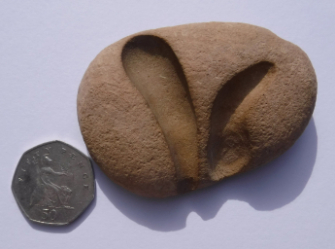
A (natural) cross-section of a stone-boring clam's lair.
Bristle Worms
Polydora ciliata
Telltale holes: small holes - only millmetres long - in a seemingly random pattern. Often u-shaped
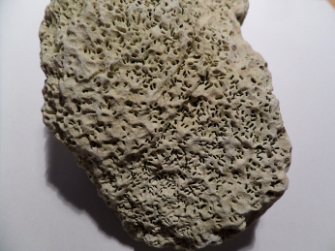
Rosser1954, CC BY-SA 3.0 <https://creativecommons.org/licenses/by-sa/3.0>, via Wikimedia Commons
This bristleworm is relatively small, gowing up to around 3cm long at most. It makes tiny u-shaped holes which we can often see as two small holes close together but we can sometimes see the 'tunnel' joining the two. The worm sticks its head out of one of the holes and filer feeds in the water.
These are usually found in softer rocks such as limestone, chalk and clay but also some shells.

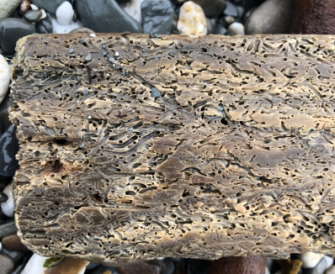
Ship worms are not worms but more clams. These burrow through wood and digest it and have caused many a ship-building to tear out their hair as their beautifully crafted vessel became lunch for an unattractive-looking wormy snail.
Until very recently, it deserved no place on this page as its boring choice is wood and not stone. However, as recently as 2019, stone-boring ship worms were discovered. (It is a good job that those frustrated ship-builders chose metal rather then stone as modern ship-building material...)
The stone-boring species haven't been seen on these shores yet but it is worth keeping an eye out for them!


